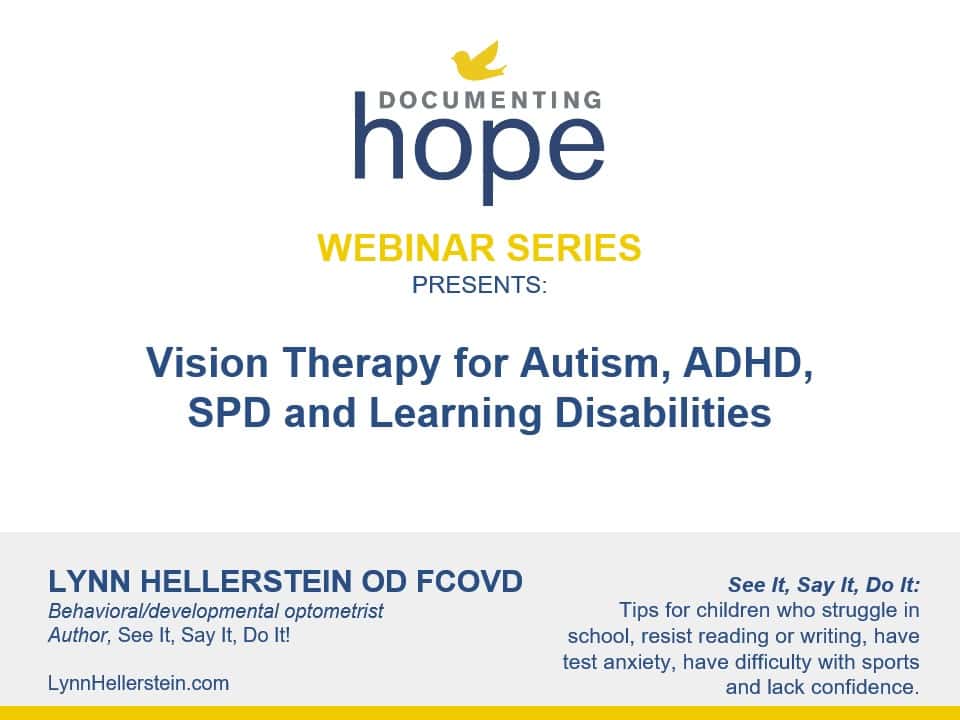In this blog post, Patricia Lemer MEd LPC explains what learning-related vision problems are and how to correct them.
An estimated 25% of school-age children have learning-related vision problems. Students can have difficulties in any of a number of areas. Maybe their two eyes don’t work together to track or focus. These and other problems can have a profound effect on how they learn.
What Are Learning-Related Vision Problems?
Symptoms of vision problems include:
- Eyes that are red or tear when stressed
- Poor hand-eye coordination
- Avoidance of academics
- Decreased comprehension
- Slow reading/writing
- Losing place
- Omitting words
- Skipping lines
- Confusion of similar words
- Discomfort
- Fatigue
- Headaches
- Short attention span when doing schoolwork
Vision Problems and/or Disabilities?
Because vision and learning are intimately connected, vision problems can be easily mistaken for learning or attention problems. Undetected and untreated vision problems can elicit some of the very same signs and symptoms commonly attributed to:
- Impulsivity
- Hyperactivity
- Distractibility
- Poor reading
- Trouble learning math
- Illegible handwriting
In some instances these conditions co-exist and treating one aspect of the problem masks the other.
Eyesight vs. Vision
Eyesight tells only how clear the image is. Vision is more than clarity. It is the brain’s ability to visualize, understand and apply the information that comes in through the eyes: the learned ability to give meaning to what is seen.
From birth, vision works together with the other senses to lay the foundation for cognition, behavior, personality and learning.
Convergence Insufficiency
David Granet, MD and researchers at the Children’s Eye Center, University of San Diego, uncovered a relationship between a common eye-teaming problem called convergence insufficiency and ADHD. In convergence insufficiency, the eyes tend to drift outward when a person is reading or doing close work. When eyes drift out, a person may have double vision.
To prevent seeing double, an individual attempts to make the eyes turn back in or converge, which then interferes with the ability to read and work comfortably at near distances. In the above study, children with convergence insufficiency were three times as likely to be diagnosed with ADHD as children without the disorder.
Does convergence insufficiency make ADHD worse, or is convergence insufficiency misdiagnosed as ADHD? In either case, patients diagnosed with ADHD should be evaluated for convergence insufficiency and treated accordingly.
Visual Function and Autism
Most individuals diagnosed with autism use visual information inefficiently. They frequently have difficulty maintaining visual attention, have eye movement disorders and have eye-teaming problems. Some of the hallmark behaviors of autism are signs of vision problems:
- Poor eye contact
- Staring at spinning objects or lights
- Side viewing
- Difficulty paying attention
Individuals with autism also often have problems coordinating their central and peripheral vision, ignoring peripheral vision, and fixating on a central point of focus for excessive periods of time.
Poor integration of central and peripheral vision can lead to difficulties in processing and integrating visual information. Motor, cognitive, speech, and perceptual abilities can also be affected when visual processing is interrupted.
A Comprehensive Vision Exam
When children are struggling, a thorough exam including the following is imperative:
- A complete developmental and health history
- A measurement of how clearly the patient can see at a distance and up close: nearsightedness, farsightedness, or astigmatism
- An assessment of eye focusing, eye teaming, and eye movement abilities (accommodation, binocular vision, ocular motility)
- An examination of the health of the eyes
Methods for evaluating the vision of non-verbal individuals vary depending upon levels of emotional and physical development. Many developmental optometrists are experienced in examining people with autism, learning disabilities and other developmental delays.
Patients are sometimes asked to perform specific activities while wearing special lenses. The doctor observes any postural adaptations and compensations the patient makes when sitting, walking, standing, or catching and throwing a ball.
Such tests help to determine how well a patient is using vision, and what can be done to improve performance. Following complete testing, the doctor reviews all findings with the patient and/or parent and provides consultation and recommendations regarding any needed treatment.
Treatment of Learning-Related Vision Problems
Depending on the results of testing, a developmental/behavioral optometrist may prescribe glasses to help the patient compensate for nearsightedness, farsightedness, astigmatism or other problems. He/she might also recommend a program of vision therapy to:
- Increase visual arousal
- Organize visual space
- Improve eye movements
- Gain more efficient eye coordination
- Enhance other important visual abilities
Individualized goals are directed toward resolving underlying visual problems that interfere with reading, learning, and behavior, as vision therapy is not an independent treatment for learning disabilities, attention deficit disorder or autism.
About Patricia S. Lemer LPC MEd
Patricia S. Lemer is a licensed professional counselor, holding a Masters of Education in counseling and learning disabilities from Boston College and a Masters in Business from Johns Hopkins University. She practiced as an educational diagnostician for over 40 years.
She was a co-founder and served as Executive Director of the international non-profit organization Developmental Delay Resources (DDR). After DDR merged with Epidemic Answers, she became Chairman of the Board. When she retired from the board, she became an emeritus board member.

She is the author of three books, the most recent of which is Outsmarting Autism, Updated and Expanded: Build Healthy Foundations for Communication, Socialization, and Behavior at All Ages (North Atlantic Books, 2019).
Lemer wrote over 50 editorials for "New Developments," the quarterly newsletter of Developmental Delay Resources (DDR), from 1995 - 2009. When DDR wound down, she wrote an online blog, "After the Diagnosis, Then What?" from 2009-2017. Her articles and blogs have been updated and archived on the Epidemic Answers website.
Since 2019, Patricia Lemer has recorded a bimonthly podcast, "The Autism Detective." In these hour-long shows, she interviews parents and professionals about their experiences in maximizing the potential of individuals on the autism spectrum. Over 100 episodes are available on Spotify and other online platforms. To learn more, go to PatriciaLemer.com and OutsmartingAutism.com
Still Looking for Answers?
Visit the Documenting Hope Practitioner Directory to find a practitioner near you.
Join us inside our online membership community for parents, Healing Together, where you’ll find even more healing resources, expert guidance, and a community to support you every step of your child’s healing journey.
Sources & References
Bakroon, A., et al. Visual function in autism spectrum disorders: a critical review. Clin Exp Optom. 2016 Jul;99(4):297-308.
Bellato, A., et al. Association between ADHD and vision problems. A systematic review and meta-analysis. Mol Psychiatry. 2023 Jan;28(1):410-422.
Bertone, A., et al. Enhanced and diminished visuo-spatial information processing in autism depends on stimulus complexity. Brain. 2005 Oct;128(Pt 10):2430-41.
Chang, M.Y., et al. Prevalence of Ophthalmologic Diagnoses in Children With Autism Spectrum Disorder Using the Optum Dataset: APopulation-Based Study. Am J Ophthalmol. 2021 Jan:221:147-153.
Davis, R.A.O., et al. Subjective perceptual distortions and visual dysfunction in children with autism. J Autism Dev Disord. 2006 Feb;36(2):199-210.
DeCarlo, D.K., et al. Prevalence of attention-deficit/hyperactivity disorder among children with vision impairment. J AAPOS. 2014 Feb;18(1):10-4.
De Jonge, M.V., et al. Visual information processing in high-functioning individuals with autism spectrum disorders and their parents. Neuropsychology. 2007 Jan;21(1):65-73.
Egset, K., et al. Magno App: Exploring Visual Processing in Adults with High and Low Reading Competence. Scandinavian Journal of Educational Research. 07 Jan 2020.
Franklin, A., et al. Reduced chromatic discrimination in children with autism spectrum disorders. Dev Sci. 2010 Jan 1;13(1):188-200.
Grigg. T.M., et al. Primitive Reflex Integration and Reading Achievement in the Classroom. Journal of Neurology and Experimental Neuroscience. 2023; 9(1), 18-26.
Ho, J.D., et al. Associations between attention-deficit/hyperactivity disorder and ocular abnormalities in children: a population-based study. Ophthalmic Epidemiol. 2020 Jun;27(3):194-199.
Kaplan, M., et al. Strabismus in Autism Spectrum Disorder. Focus on Autism and Other Developmental Disabilities. 1999.
Koh, H.C., et al. Spatial contrast sensitivity in adolescents with autism spectrum disorders. J Autism Dev Disord. 2010 Aug;40(8):978-87.
Johnson, B.P., et al. Ocular motor disturbances in autism spectrum disorders: systematic review and comprehensive meta-analysis. Neurosci Biobehav Rev. 2016 Oct:69:260-79.
Khanna, R.K., et al. Ophthalmological findings in children with autism spectrum disorder. Graefes Arch Clin Exp Ophthalmol. 2020 Apr;258(4):909-916.
Little, J.A. Vision in children with autism spectrum disorder: a critical review. Clin Exp Optom. 2018 Jul;101(4):504-513.
Maron, D.N., et al. Oculomotor deficits in attention deficit hyperactivity disorder (ADHD): a systematic review and comprehensive meta-analysis. J Autism Dev Disord. 2006 Feb;36(2):199-210.
Milne, E., et al. Vision in children and adolescents with autistic spectrum disorder: evidence for reduced convergence. J Autism Dev Disord. 2009 Jul;39(7):965-75.
Mouridsen, S.E., et al. Eye Disorders among Adult People Diagnosed with Infantile Autism in Childhood: A Longitudinal Case Control Study. Ophthalmic Epidemiol. 2017 Oct;24(5):332-335.
Padula, W.V., et al. Modifying postural adaptation following a CVA through prismatic shift of visuo-spatial egocenter. Brain Inj. 2009 Jun;23(6):566-76.
Padula, W.V., et al. Risk of fall (RoF) intervention by affecting visual egocenter through gait analysis and yoked prisms. NeuroRehabilitation. 2015;37(2):305-14.
Padula, W.V., et al. The consequence of spatial visual processing dysfunction caused by traumatic brain injury (TBI). Brain Inj.. 2017;31(5):589-600.
Padula, W.V., et al. Visual evoked potentials (VEP) evaluating treatment for post-trauma vision syndrome (PTVS) in patients with traumatic brain injuries (TBI). Brain Inj. 1994 Feb-Mar;8(2):125-33.
Perna, J., et al. Association between Autism Spectrum Disorder (ASD) and vision problems. A systematic review and meta-analysis. Mol Psychiatry. 2023 Dec;28(12):5011-5023.
Reimelt, C., et al. The underestimated role of refractive error (hyperopia, myopia, and astigmatism) and strabismus in children with ADHD. J Atten Disord. 2021 Jan;25(2):235-244.
Robertson, C.E., et al. Tunnel vision: sharper gradient of spatial attention in autism. J Neurosci. 2013 Apr 17;33(16):6776-81.
Sarno, S., et al. Electrophysiological correlates of visual impairments after traumatic brain injury. Vision Res. 2000;40(21):3029-38.
Simmons, D.R., et al. Vision in autism spectrum disorders. Vision Res. 2009 Nov;49(22):2705-39.
Song, Y., et al. Can they see it? The functional field of view is narrower in individuals with autism spectrum disorder. PLoS One. 2015 Jul 23;10(7):e0133237.
Su, C.C., et al. Incidence and risk of attention-deficit hyperactivity disorder in children with amblyopia: a nationwide cohort study. Clin Exp Ophthalmol. 2019 Mar;47(2):259-264.
Van der Hallen, R., et al. Global Motion Perception in Autism Spectrum Disorder: A Meta-Analysis. J Autism Dev Disord. 2019 Dec;49(12):4901-4918.
Wang, J., et al. Refractive Status and Amblyopia Risk Factors in Chinese Children with Autism Spectrum Disorder. J Autism Dev Disord. 2018 May;48(5):1530-1536.
Whatham, A., et al. Vitamin and mineral deficiencies in the developed world and their effect on the eye and vision. Ophthalmic Physiol Opt. 2008 Jan;28(1):1-12.
Resources
Articles
CBS Chicago: Vision Problems In Kids Can Be Misdiagnosed For ADHD
Move, Play, Thrive: Vision Doctor on Rhythmic Movements + Research about Visual Processing Issues.
Books
Hellerstein, Lynn. 50 Tips to Improve Your Sports Performance. HiClear Publishing LLC, 2013.
Hellerstein, Lynn. Expand Your Vision Beyond Sight.HiClear Publishing LLC, 2012.
Hellerstein, Lynn. Organize It. HiClear Publishing LLC, 2010.
Hellerstein, Lynn. See It, Say It, Do It. HiClear Publishing LLC, 2012.
Lemer, Patricia S. Envisioning a Bright Future: Interventions That Work for Children and Adults with Autism Spectrum Disorders. Optometric Extension Program Foundation, 2008.
Videos
Catching a Ball for the First Time at 39: Justin’s Story
Vision Therapy Transformed Our Son’s Life: Atlas’ Story
Websites
Neuro-Optometric Rehabilitation Association
Optometric Vision Development Rehabilitation Association







